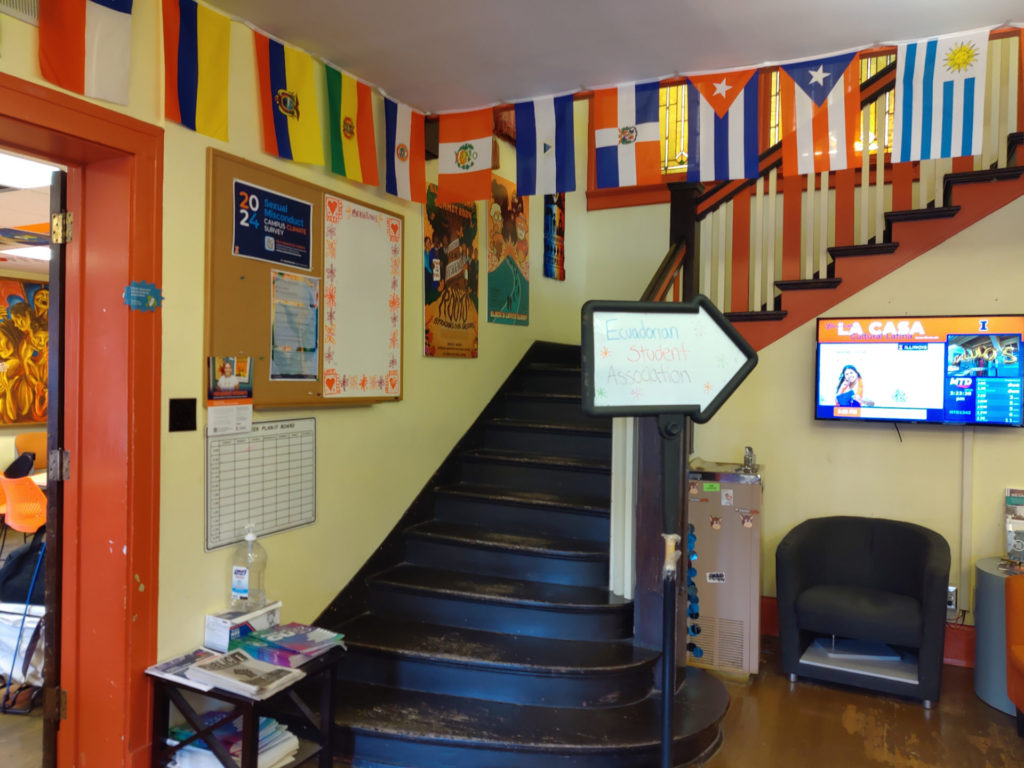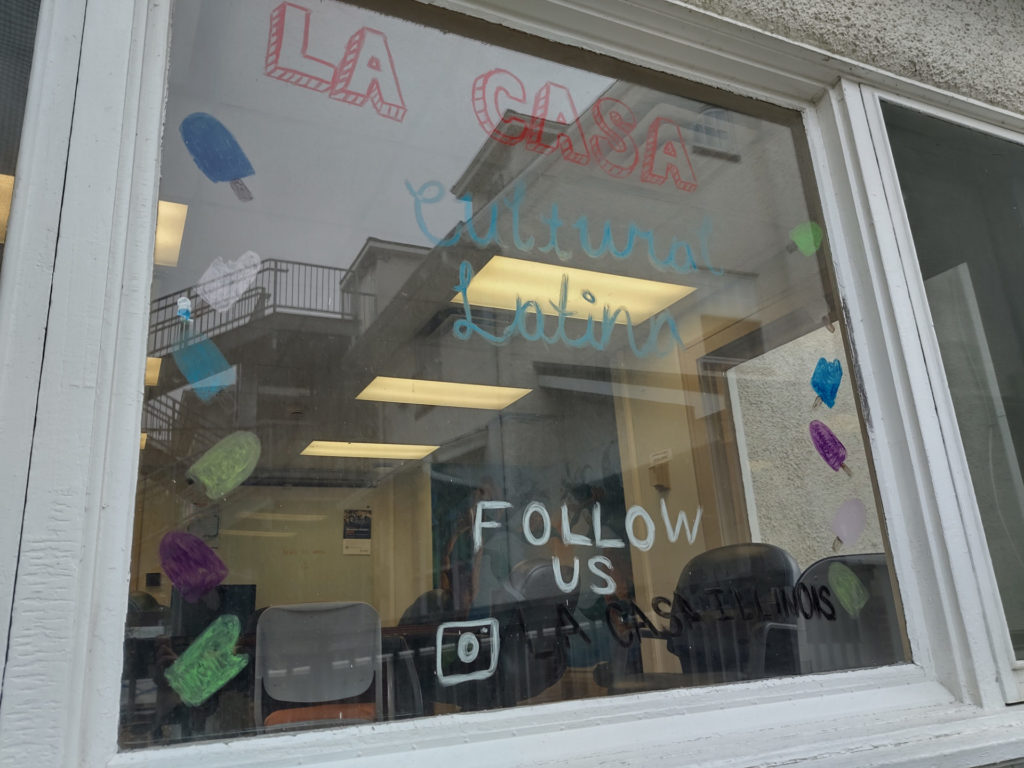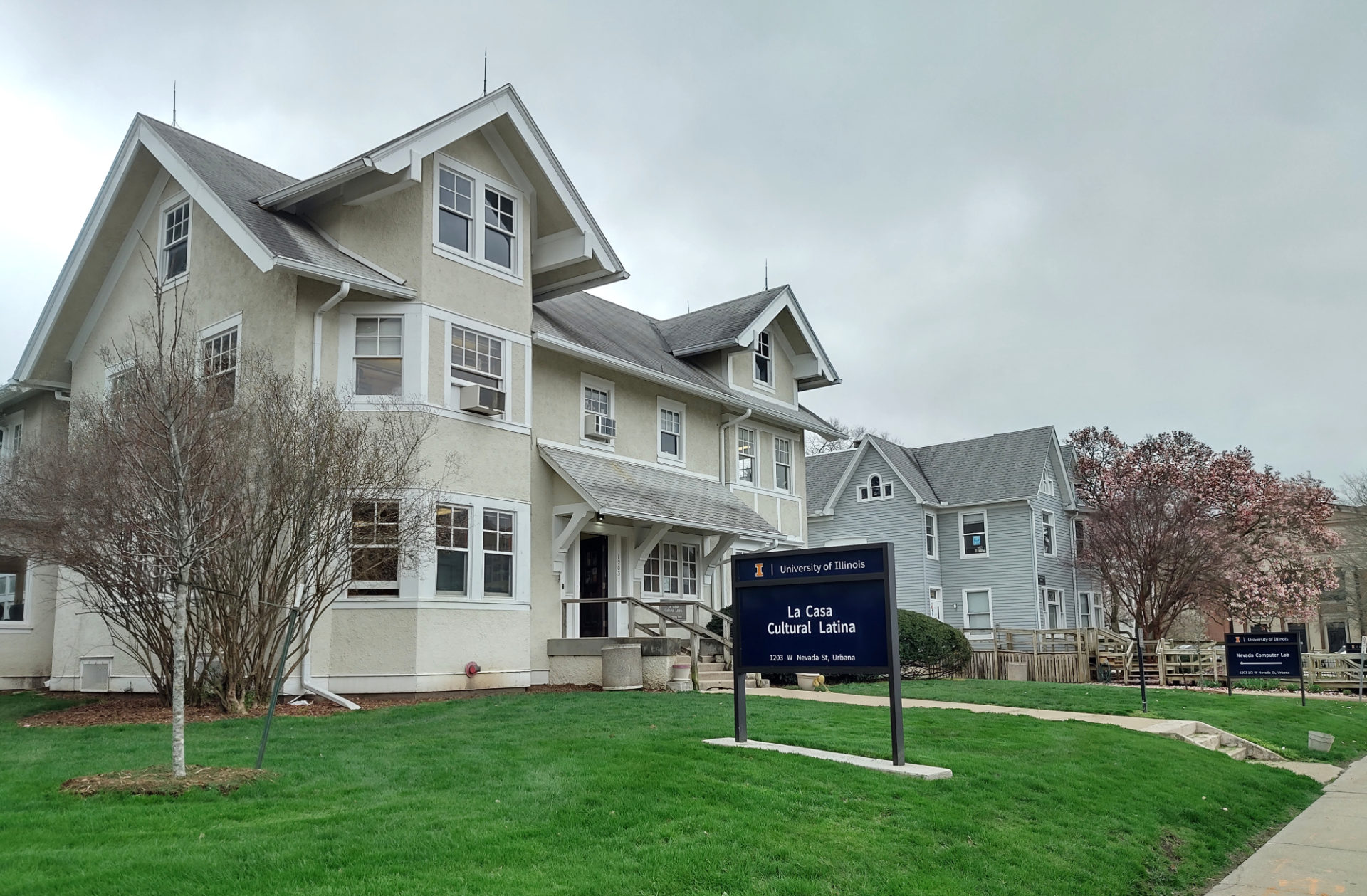Every time I walk into La Casa Cultural Latina at 1203 West Nevada in Urbana, the small but numerous rooms are bursting with music and students. Friends call to one another across the crowded hallway and, inevitably, one student sits over by the welcome table to point people in the right direction.
On the day I came to meet with Mariana Ortega, Director of La Casa, one of the students shouts above the laughter and conversation to direct me up the stairs, past the stained glass windows, into a space that is clearly designed for students. Pamphlets and resources, directions for navigating bureaucracy and the kinds of everyday items a student might need, like Kleenex, line the walls. This community of care is still growing, and it still upholds the mission that was set out by students for students over 50 years ago.
On April 23, 1974, a letter arrived on the desk of the Vice Chancellor for Campus Affairs. Signed by the members of La Colectiva Latina, it called for a creative and concrete space for the emerging Latiné population on campus. The university, in 1968, had admitted 500 minority students to the campus, the first initiative of its kind at the University of Illinois Urbana-Champaign, but their efforts stopped at admission. The students arrived and found a predominantly white campus, few resources, and no access to cultural spaces, or even ways of finding one another amidst so many arriving freshmen.
The U of I chose a color-blind approach. Many were supportive, but others stated clearly that they never expected Latino/Latina students to integrate fully into the campus. They used words like “normal” to describe the white population on campus and “deficient” to describe the students advocating for La Casa.
It fell to students to create the space they needed. In the letter, La Colectiva demonstrated how a space like La Casa would improve retention by connecting people with both academic spaces and cultural ones. Meanwhile, it would serve the needs of the university as a whole by expanding its cultural, social, and intellectual horizons. They also advocated for curriculum and hiring decisions that would reflect ways of knowing other than the Western tradition. They continued to write letters, meet with administrators, and hold protests on campus until what would become La Casa was founded later that year.
Student activism is still alive and well on campus. In 1992, La Casa students organized a series of sit-ins to call for increased representation and retention of the Latiné community in students and faculty alike. They also supported the protests by American Indian students against Chief Illiniwek. In 2015, students advocated for the preservation of a series of protest murals painted in 1974 in support of La Colectiva.
This year, La Casa celebrates 50 years since they first opened their doors on East Chalmers Street. Mi Casa, Tu Casa, La Casa, Celebrando 50 y Más! will last for three days, April 5-7, and everyone is invited. Whether you’re a student on campus or a member of the larger Illinois community, please join La Casa in dancing, workshops, and lots and lots of food. Perhaps you, too, will find a home away from home.
To kick off the celebration, I sat down with Director Ortega to talk about La Casa, its history, and the 50th anniversary. She is joined by a “mighty team” of undergraduate students and staff, including assistant directors Stephanie Cordoza-Cruz and Julio Velasco, as well as office support Jenny Humphrey. As she says, “They are the ones who do it all!” In addition to inviting everyone to the 50th, she wants students and community members to know they are always welcome at La Casa.
This interview has been edited for length and clarity.
Smile Politely: Today, we’re focused on the 50th anniversary, and I had read that the cultural house began because of a series of protests. Is that right?
Mariana Ortega: What’s really interesting is that, yes, we have all been founded off of student activism, but specifically for La Casa, it was actually groups of students that advocated for a space like La Casa. It stems back even before 1974 to a group of students, an organization called the Urban Hispanic Organization of students, saying, “We need a place,” especially for those that were experiencing potentially different harm on campus. That group then became La Colectiva, and that was a very activist group that then spearheaded the initiatives to get a new La Casa.
Although the University of Illinois was somewhat supportive, it’s really important, especially as we celebrate 50 years, that we recognize that it’s actually students who led the movement. I think from a public’s eye, sometimes it looks like the University of Illinois jumped on board and gave Latiné students this house. It was really from grassroots [organizing by] students. What’s really important in our history is that La Colectiva also had their list of what they wanted La Casa to look like. The bicultural, bilingual programs department at the time also had their list of what they wanted La Casa to look like. Through them having meetings, through them really advocating for needing a space and protesting for it, that list was made and still shapes how we think of our needs at La Casa. So, yes, the bigger answer is, we exist because of students and students really holding the institution accountable, which I think is a big piece that we sometimes don’t necessarily always mention.
SP: Definitely. And I feel like that’s the role that the cultural houses really do serve. They’re not just university gifts to us all. Can you talk a little bit more about how students’ needs weren’t being met, that list that they brought to the table?
Ortega: I think, from the beginning, students wanted a space. Through the years, we outgrew 510 East Chalmers, which is now why we’re at 1203 West Nevada. So, there is still a need for space. Even today, sometimes, we are triple booked. We serve a ton of students, and we don’t have the space yet to even serve who we’re serving.
As to that list, it was that they wanted to see themselves represented on this campus. I think we have slowly increased in Latiné numbers, but there’s still work to be done in that increase of representation of students. Students did want to see themselves among faculty and staff. It varies because we are still living a modern version of those demands and there is still a need for improvement and not just settling for “We have this and that’s it” because of where we started in 1974. Instead, we have this, but is what we have what is needed now? We do need more and to have enough resources to then serve the current needs of students.

SP: With those needs in mind, people outside of the cultural houses don’t necessarily see inside the cultural houses, so how does La Casa serve their students? What kind of roles does this community play?
Ortega: I love that question because it’s such a complex answer. Yes, a lot of times the local community sees us as the center that puts on programs and where we celebrate our culture. And yes, that’s a pillar in our mission, but there’s also this level of advocacy of students. If a student has already advocated for themselves and they’re still running into a barrier on this campus, they come here and we figure it out. It’s really about us picking up the phone and saying, “Hey, what’s going on?” That advocacy is a really big piece of serving a population that is only 11% on this campus.
For a student to preserve their identity and their culture at this predominantly white institution, being able to do that leads to success and leads to graduation. I can only speak for La Casa, but a space like La Casa allows students to walk in and say, “I can still hang on to my culture, be my true authentic self and succeed here because if I am navigating something or if I’m running into imposter syndrome, I can walk into that space and feel seen and heard or mentored.” It’s what that means for a student being able to persevere in their identity and its connection to not just success, but belonging.
From the moment the student is admitted, we know that family is a big piece in our culture, so we also engage families. In the Fall, parallel to dad’s weekend, we have our big Latino Family Visit Day; spring, parallel to mom’s weekend, our big Mother’s Day brunch, Día de las Madres; [registration] just closed and, in 11 minutes, hit capacity. So, that tells you the need. We also have an early arrival program, three days when the families are part of the first day and we talk about some transitional advice that families might need. Plus, we have weekly programs at La Casa, and we have resources embedded here, like someone from the Counseling Center or Women’s Resource Center hosting hours here, and many more.
So, it’s the cultural programming, it’s family involvement, but it’s really the sense of belonging that’s included with success. It’s a hub for students. It’s also just a space where students come and hang out. Sometimes I like to say we are almost this mini-Latino student union, in a sense. Students are coming in and they’re using this space — whether it’s to study, to be in community, to blast music, to empower one another, to gossip, whatever it is, to feel heard and seen. I think there’s a lot of generational support that happens, too. You hear upperclassmen encourage underclassmen if they’re going through something or you hear these conversations of “You would be so great for that. You got this. Do it.” And that happens in this space organically because just the beauty of what this space is.
SP: As you know, students often don’t know what a very white-serving campus like Illinois can offer them. What would you want to say to those students, prospective students, current students who feel that they’re alone, or don’t know that this community is here?
Ortega: That would be a two part answer. For incoming students, sign up for Conéctate. It’s our early arrival program and that not only gives you a taste of La Casa but also helps in that transition, especially because we’ve built in so much solidarity work with the other cultural centers, so they start to engage with the other centers before they even start.
And don’t be afraid to come, just walk into our space, come into an event, come to our first day of classes. We have Paleta Social, which is our huge welcome back event. Just come to that and you are already going to feel part of the community.
For a current student where maybe it’s intimidating, don’t feel like you have to fit a certain lens of our identity and our culture to come into this space. To often, students overthink: “Well, I don’t speak Spanish, so am I allowed in?” or “Well, I’m a second, third, fourth generation immigrant.” And the reality is, there is not a one type of Latina/Latino/Latiné individual. We aren’t monolithic. We come from different backgrounds, different stories. We’re at different points of intersectional generation from our families and our countries. Just come and be in community. You don’t even have to tell us you’re here. And if that’s too intimidating, that’s okay. Follow us on social media @lacasaillinois and maybe there’s an event that draws your attention, and just come to the event.

SP: And what about people in the community, people outside of the university?
Ortega: Yes! Anyone. All our events are open to the community, and we have a kindergarten through fifth grade program called Niños. We give you a shirt and that way we know they’re with the program, and we can at least make it a more inviting environment, especially if they feel lost among a bunch of college students. And you may not have a traditional family and you may not have kids and that’s okay. You are welcome here.
SP: That’s amazing. As we sort of wrap up here, is there just anything else you want to tell our readers?
Ortega: Come out to our 50th celebration because it’s 50 years of the Latina/o/x/é joys and struggles on this campus, but also the community played a lot into that. The community piece adds to our student experience. I’ll never forget a student: They were doing our early arrival program, and we have the students go to Black and Brown businesses on the bus so they learn public transportation, but also they can feel seen and heard. And one of the students said, “I never realized that being from Chicago coming to the middle of the cornfields in Central Illinois, that I would see myself in the community.”
So, as intimidating as an institution feels, just come because it is important for our local community, especially the youth, to come because I think these are the spaces where then they see themselves at a young age as part of this future vision.
Mi Casa, Tu Casa, La Casa, Celebrando 50 y Más!
1203 West Nevada Street
Urbana
Apr 5-7; check schedule for specific programming
Free








